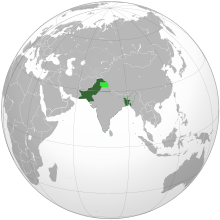East Bengal was the most populous province in the new Pakistani federation led by Governor General Muhammad Ali Jinnah in 1947, with Dacca as the provincial capital.[69] While the state of Pakistan was created as a homeland forMuslims of the former British Raj, East Bengal was also Pakistan's most cosmopolitan province, being home to peoples of different faiths, cultures and ethnic groups. In 1950, land reform was accomplished in East Bengal with the abolition of the permanent settlement and the feudal zamindari system.[70]
The successful Bengali Language Movement in 1952 was the first sign of friction with West Pakistan.[71] The One Unit scheme renamed the province as East Pakistan in 1955. The Awami League emerged as the political voice of the Bengali-speaking population,[72] with its leader H. S. Suhrawardy becoming Prime Minister of Pakistan in 1956. He was ousted after only a year in office due to tensions with West Pakistan's establishment and bureaucracy.[73]
The 1956 Constitution ended dominion status with Queen Elizabeth II as the last monarch of the country. Dissatisfaction with the central government increased over economic and cultural issues. The provincial government of A. K. Fazlul Huq was dismissed on charges of inciting secession.[74] In 1957, the radical left-wing populist leader Maulana Bhashaniwarned that the eastern wing would bid farewell to Pakistan.[75]
The first Pakistani military coup ushered the dictatorship of Ayub Khan. In 1962, Dacca was designated as the legislative capital of Pakistan in an appeasement of growing Bengali political nationalism.[76] Khan's government also constructed the Kaptai Dam which controversially displaced the Chakma population from their indigenous homeland in the Chittagong Hill Tracts.[77] During the 1965 presidential election, Fatima Jinnah failed to defeat Field Marshal Ayub Khan despite strong support in East Pakistan.[78]
According to senior international bureaucrats in the World Bank, Pakistan applied extensive economic discrimination against the eastern wing, including higher government spending on West Pakistan, financial transfers from East to West and the use of the East's foreign exchange surpluses to finance the West's imports.[79] This was despite the fact that East Pakistan generated 70%[80] of Pakistan's export earnings with jute and tea.[79] East Pakistani intellectuals crafted the Six Points which called for greater regional autonomy, free trade and economic independence. The Six Points were championed by Awami League President Sheikh Mujibur Rahman in 1966, leading to his arrest by the government of President Field Marshal Ayub Khan on charges of treason. Rahman was released during the 1969 popular uprising which ousted President Khan from power.
Ethnic and linguistic discrimination was abound in Pakistan's civil and military services, in which Bengalis were hugely under-represented. In Pakistan's central government, only 15% of offices were occupied by East Pakistanis.[81] They formed only 10% of the military.[82] Cultural discrimination also prevailed, causing the eastern wing to forge a distinct political identity.[83] Pakistan imposed bans on Bengali literature and music in state media, including the works of Nobel laureate Rabindranath Tagore.[84] In 1970, a massive cyclone devastated the coast of East Pakistan killing up to half a million people.[85] The central government was criticized for its poor response.[86] After the elections of December 1970, calls for the independence of Bangladesh became stronger.[87]


No comments:
Post a Comment